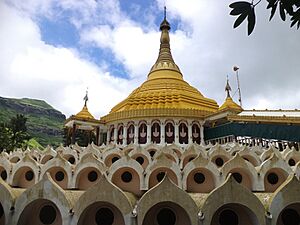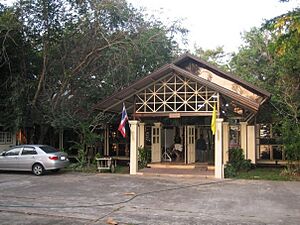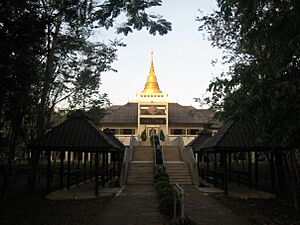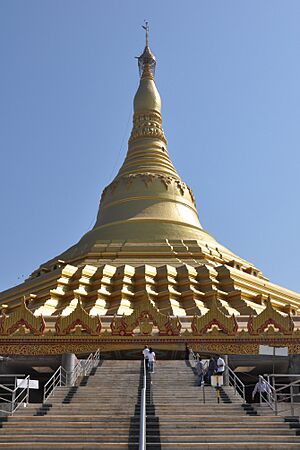S. N. Goenka facts for kids
Quick facts for kids
S. N. Goenka
|
|
|---|---|
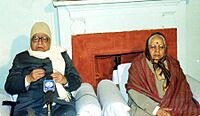
S. N. Goenka with his wife while speaking at a talk on Values in Education - Good Governance through Vipassana Meditation
|
|
| Born |
Satya Narayan Goenka
30 January 1924 |
| Died | 29 September 2013 (aged 89) |
| Nationality | Burmese (1924–1979) Indian (1979–2013) |
| Occupation | Vipassana meditation teacher |
| Title | U |
| Spouse(s) | Elaichi Devi Goenka |
| Awards | Padma Bhushan (2012) |
Satya Narayana Goenka (born January 30, 1924 – died September 29, 2013) was an important teacher of vipassanā meditation. He was born in Burma (now Myanmar) to an Indian business family. In 1969, he moved to India and began teaching meditation.
Goenka taught that the Buddha's way to freedom was for everyone, no matter their religion. He said it was also very scientific. He became a well-known teacher and helped set up many non-profit Vipassana meditation centers around the world. In 2012, the Government of India gave him the Padma Bhushan award. This award is for people who have done great service.
Contents
Who was S. N. Goenka?
Goenka was born on January 30, 1924, in Burma. His parents were Indian and from the Marwari group. He grew up in a traditional Hindu home.
He was a very successful businessman. But in 1955, he started getting very bad migraine headaches. Doctors could not help him. A friend suggested he meet a Vipassana teacher named Sayagyi U Ba Khin. Goenka was not sure at first, but Ba Khin accepted him as a student. Goenka then studied with him for 14 years.
Goenka's Journey to Teach Meditation
In 1969, Goenka was given permission to teach by his teacher, Sayagyi U Ba Khin. His teacher passed away in 1971. Goenka left his business to his family and moved to India. There, he opened his first Vipassana meditation center in Hyderabad.
Seven years later, in 1976, he opened his first main meditation center. It was called Dhamma Giri and was located in Igatpuri, near Nashik, Maharashtra. He taught meditation by himself until 1982. Then, he started training other teachers to help him. In 1985, he created the Vipassana Research Institute at Dhamma Giri.
From the very beginning, he taught 10-day meditation courses. By 1988, he had taught thousands of people, including many from Western countries.
Today, Vipassana courses, following the teachings of Sayagyi U Ba Khin, are held in 380 places in 94 countries. About 241 of these are permanent meditation centers. These centers are in many places, including Argentina, Australia, Canada, France, Germany, Japan, Mexico, New Zealand, the United Kingdom, the United States, and 78 centers in India.
In 2000, Goenka started building the 325-foot-high Global Vipassana Pagoda. It is near Gorai Beach in Mumbai and opened in 2009. This pagoda holds special items of the Buddha and has a large meditation hall. It was built to honor his teacher, U Ba Khin. U Ba Khin wanted to give back to India, where Vipassana meditation began. However, he could not get a passport, so he never got to visit India himself.
Speaking at the United Nations
Goenka was invited to speak at the Millennium World Peace Summit. This event brought together religious and spiritual leaders. It took place on August 29, 2000, at the United Nations headquarters in New York City.
Later Years and Recognition
Goenka was also a great speaker, writer, and poet. He wrote in both English and Hindi. He traveled a lot and gave talks to people all over the world. This included speaking at the World Economic Forum in Davos. In 2002, he went on a four-month "Meditation Now Tour" across North America.
In 2012, he received the Padma Bhushan award. This is India's third-highest award for civilians. He received it for his social work on India's 63rd Republic Day.
He passed away on September 29, 2013, at his home in Mumbai. His wife, Elaichi Devi Goenka, who was also a meditation teacher, and his six sons survived him.
Goenka's Lasting Impact
Goenka trained about 1350 assistant teachers. These teachers use his recordings to lead courses. About 120,000 people attend these courses every year.
After Goenka's death, Jack Kornfield, a famous American writer on Buddhism, said: "Some great teachers shine a light for the world. Like the Dalai Lama and Thich Nhat Hanh, S.N. Goenka was one of the great masters of our time." He also mentioned that Goenka inspired many Western thinkers and spiritual leaders. Jay Michaelson wrote in a Huffington Post article that Goenka was a key teacher for the first group of "insight" meditation teachers in the United States.
What Goenka Taught
The meditation technique Goenka taught is believed to come from the Buddha himself. You do not need to change your religion to practice it. Goenka explained that the Buddha did not teach a specific religion. Instead, he taught Dhamma – a way to liberation (freedom). This way is for everyone.
"Liberation" here means freeing your mind from bad thoughts. When your mind becomes pure, you also become free from suffering. Goenka described Vipassana meditation as a scientific practice. In it, you observe how your mind and body are always changing. This helps you understand yourself deeply, leading to a truly happy and peaceful life.
Courses begin by observing your natural breath. This helps your mind become focused. This practice is called Anapana. Once your mind is focused, you move on to Vipassana. In this tradition, Vipassana means watching your body sensations calmly. This helps you become more aware of how your mind and body are connected.
The Ideas Behind the Teaching
Goenka believed that understanding the ideas behind Vipassana is important. However, he stressed that practicing the technique is the most important part. Students are free to accept or reject any part of the ideas he taught.
Goenka often shared words from the Buddha:
"Filled with these compassionate and loving thoughts he proclaimed:
Apārutā tesaṃ amatassa dvārā Ye sotavanto pamuñcantu saddhaṃ
Open are the gates of the deathless state to those with ears (who can hear) who renounce their lack of faith"
Vipassana Meditation Centers
The Vipassana Meditation Centers that Goenka helped create offer 10-day courses. These courses give a full introduction to Vipassana meditation. There are no fees for the course, or for food and a place to stay. These courses are supported by donations from people who want to help future students. Only donations made at the end of a course go towards helping new students.
The centers are run by volunteers and are independent. To make sure the experience is similar at all centers, all public teaching during the retreat uses Goenka's audio and video recordings. When asked about problems with growth, Goenka said:
The cause of the problem is included in the question. When these organisations work for their own expansion, they have already started rotting. The aim should be to increase other people’s benefits. Then there is a pure Dhamma volition and there is no chance of decay.
When there is a Dhamma volition, "May more and more people benefit," there is no attachment. But if you want your organisation to grow, there is attachment and that pollutes Dhamma.
Students at Goenka's centers are asked not to practice other religious or meditative methods during the course. Goenka explained: "The names of many practices are all words of pure Dhamma, of Vipassana. But today the essence is lost; it is just a lifeless shell that people perform. And that has no benefit."
The Global Vipassana Pagoda
One of Goenka's dreams came true in November 2008. The Global Vipassana Pagoda was finished near Mumbai. He hoped this building would help connect different communities, groups, countries, and people. He wanted it to make the world more peaceful.
The Pagoda has the world's largest stone dome without pillars. It is expected to attract many visitors from all over the world. They can learn about the pagoda and Vipassana meditation. This building is the largest single-span stone dome in the world. It is twice as big as the Basilica of St. Peter at the Vatican. Inside, there is a round meditation hall, 280 feet wide. It can hold 8,000 people. At 325 feet tall, it is almost as high as a 30-story building. About 2.5 million tons of stone were used to build it.
In a 1997 article, Goenka explained why the Pagoda was built. He said it would hold special items believed to be from the Buddha. He believed these items actually help people:
Usually such pagodas are solid. But with the help of the most modern techniques of architecture, instead of building a solid pagoda, a vast meditation hall will be built within it, at the centre of which these sacred relics will be installed so that thousands of meditators can sit around them, meditating together and benefit from their Dhamma vibrations.
Vipassana Research Institute
Goenka believed that understanding the ideas and practicing meditation should go together. So, he started the Vipassana Research Institute. This institute studies Vipassana and its effects. It also publishes books and articles about it. The Vipassana Research Institute focuses on two main things: translating and publishing old Pali texts, and researching how Vipassana can be used in daily life.
Vipassana in Prisons
Goenka was able to bring Vipassana meditation into prisons. This started in India and then spread to other countries. The organization estimates that about 10,000 prisoners have taken the 10-day courses. Many police and military members have also attended.
Doing Time, Doing Vipassana is a 1997 documentary film. It is about how S. N. Goenka's 10-day Vipassana classes started at Tihar Jail in 1993. This happened because Kiran Bedi, who was in charge of prisons in New Delhi, introduced them. Bedi first had her guards trained in Vipassana. Then, Goenka gave his first class to 1,000 prisoners.
The Dhamma Brothers is another documentary film from 2007. It is about a Vipassana meditation program at William E. Donaldson Correctional Facility in Bessemer, Alabama. The film focuses on four inmates who were convicted of murder. It also includes talks with guards, prison officials, and local people.
Famous Sayings by Goenka
- "May all beings find real peace, real harmony, real happiness."
- "A teacher should not be made an idol, like a god. He is a teacher. If you want to get any help, you practice what is being taught, that's all." (Indian Express interview, 2010)
- "I am not against conversion. In my speech at UN, the first thing I said was that I am for conversion, but not from one organised religion to another, but from misery to happiness, from bondage to liberation." (Indian Express interview, 2010)
- (On rituals) "...if my teacher had asked me to perform rites or rituals, I would have said good-bye. My own Hindu tradition was full of rituals and ceremonies, so to start again with another set of rituals didn't make sense. But my teacher said, 'No ritual. Buddha taught only sila, samadhi, paññā. Nothing else. There is nothing to be added and nothing to be subtracted.' As the Buddha said, 'Kevalaparipunnam.' (Pali: 'The whole technique is complete by itself.') "(Shambhala Sun interview, 2001)
- "People are attracted by the results of the practice that they see in others. When a person is angry, the influence of that anger makes everybody unhappy, including themselves. You are the first victim of your own anger. This realization is another thing that attracted me to the Buddha's teaching." (Shambhala Sun interview, 2001)
See also
- Sayagyi U Ba Khin
- Vipassana movement
- Dhamma Joti
- Global Vipassana Pagoda
- List of converts to Buddhism from Hinduism


